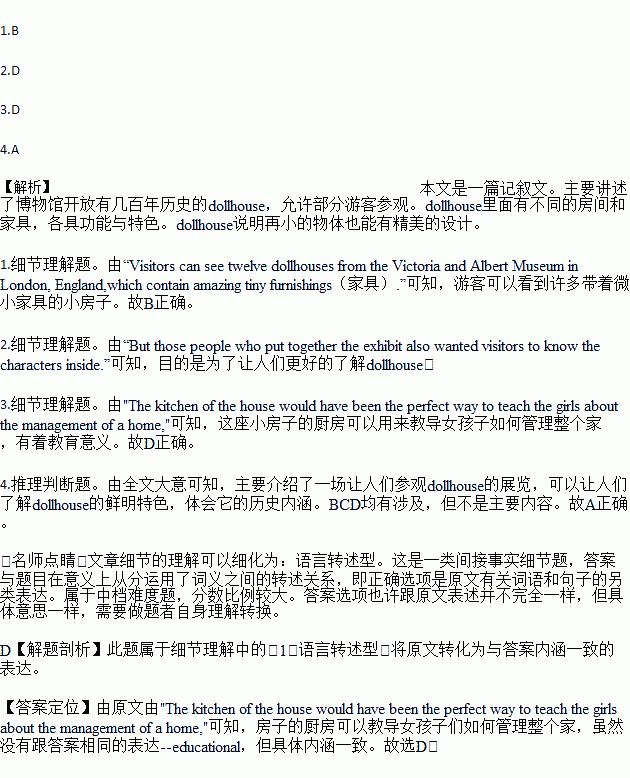题目内容
When people today talk about a tiny house, they probably mean the trendy living space that‘s about the size of a shed (棚). But you would have to be five inches tall to live in the original tiny houses. Dollhouse(小房子),which have been around for several centuries, don’t offer shelter to real people, but they provide a vivid(生动的) experience of life in times and places both real and imaginary.
The National Building Museum in Washington, D.C., lets visitors time travel in this tiny world through ―Small Stories: At Home in a Dollhouse,” an exhibit that opened Saturday. Visitors can see twelve dollhouses from the Victoria and Albert Museum in London, England, which contain amazing tiny furnishings. But those people who put together the exhibit also wanted visitors to know the characters inside.
“It’s 300 years of British homes told through their inhabitants (居民),” said Alice Sage, who is in charge of the London museum.
So as visitors look inside the Tate Baby House, a fancy townhouse from 1760, they can push a button to hear a young woman get a lecture from her mother on the proper way to run a home. In the Killer Cabinet house, a servant named Betsy complains about the problems of city life in the 1830s. “We’ve got the cat to keep the rats away,” she says.
That dollhouse was John Killer‘s gift to his wife and five daughters. The girls were allowed to play with the house, but they probably also learned a few lessons, Sage said.
“The kitchen of the house would have been the perfect way to teach the girls about the management of a home,” she said, noting the tiny dishes and pots.
Those who prefer a more modern look won't be disappointed. There are two rooms displaying a white dollhouse from 1935, an apartment house from the 1960s and a brightly colored 21st-century design.
The end of the exhibit shows how imaginative design sometimes works best in small spaces.
The Building Museum asked twenty-four artists, designers and architects from across the United States to each create a “dream room” from the past, present or future. Some of these unique small rooms were made using traditional furnishings, others from materials such as clay, insects, 3D-printing, and even peeps marshmallow candies!
1.Which of the following were on show Saturday?
A. A dozen dollhouses from England.
B. Some old shelters for poor people.
C. Some imaginary tiny furnishings.
D. A couple of fashionable living spaces.
2.What is the function of the characters inside the Museum?
A. Working as organizers of the exhibit.
B. Making the exhibit more attractive.
C. Providing good services for visitors.
D. Helping visitors understand dollhouses.
3.What can we learn about the Killer Cabinet house?
A. It was made up of 24 tiny rooms.
B. Its kitchen may have an educational purpose.
C. Its history dates back to the 17th century.
D. It was owned by a woman named Betsy.
4.What might be the best title of the passage?
A. An exhibit of dollhouses.
B. The history of dollhouses.
C. How to make a dollhouse.
D. Amazing tiny furniture.
 阅读快车系列答案
阅读快车系列答案
